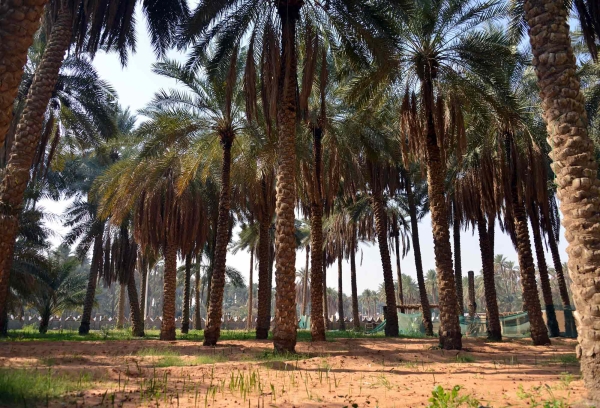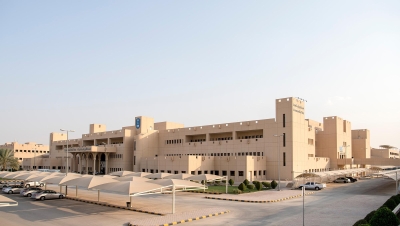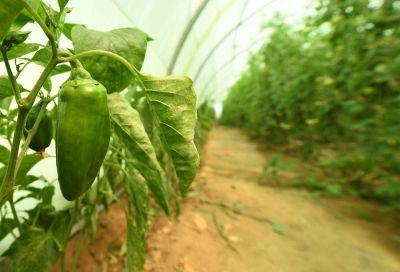

Palm Care in the Kingdom of Saudi Arabia refers to the agricultural care processes carried out by farmers. These practices include offshoot care, irrigation, trimming, pruning, skirting, defibring, and covering. The Kingdom has placed significant importance on palm trees. The Ministry of Environment, Water, and Agriculture provides several services for the care of palm trees in the Kingdom, including guidance services, methods for controlling pests, insects, and diseases, and organizing agricultural seminars.
Offshoot (al-wadeyyah) care after planting
Palm tree offshoots are planted immediately after removal or upon reaching the planting site, positioned slightly tilted. They are arranged in straight parallel rows, with a maximum of ten m between each tree. The offshoots are wrapped in burlap or palm fibers, and a small basin called 'Faqrah' is dug around them. The success rate decreases if planting is delayed, as the offshoots may dry out if left unplanted for too long. The best times for planting palm trees are from mid-February to the end of April, during spring. The fall planting season begins in mid-July and lasts until the end of September.
Palms irrigation in Saudi Arabia
Palm trees require sufficient water supply throughout their growth stages to maintain a good fruit yield. When palm trees are subject to thirst, fruit growth is delayed, fruits fall off, and their quality decreases. On the other hand, over-irrigation leads to soil saturation, increased moisture around the base of the palm tree, rotting, and diseases and pest infestation, particularly the red palm weevil.
Palm trees are irrigated by creating a small circular soil basin around the offshoot. The palm is watered daily with cool water for forty days, then every five days after its first year. There are various methods for irrigating palm trees, including flood irrigation, subsurface irrigation, bubbler irrigation, and drip irrigation.
Palms fertilization in Saudi Arabia
Fertilization is a crucial stage in palm tree care, providing essential nutrients to nourish the palm tree. Organic fertilizer is commonly used, spread around the palm in the basin while keeping it away from the lower trunk to prevent (al-Aqr). The soil is then covered and watered.
Chemical fertilizers, whether single or compound, are used depending on the palm's age and soil type. Additionally, green manure is applied by planting crops such as alfalfa, millet, al-Hesneya, cowpeas, and ghaf trees, by plowing the land and burying the plants while still green to decompose and enrich the soil.
Palms pruning in Saudi Arabia
Pruning, or trimming, is a key step in palm tree maintenance, involving the removal of dry and green fronds that have ceased to function. This is done once a year, typically before the pollination process. It is recommended to perform pruning during the winter months to avoid the active periods of the red palm weevil, as the pheromones released from the wounded palm tissue attract the pest.
Palms skirting in Saudi Arabia
Skirting palm trees involves cutting off the base of the fronds leaves at the level of the fibers, in a horizontal, outward-sloping pattern. This helps prevent the accumulation of water and fallen dates between the trunk and the base of the fronds. Additionally, dead offshoots around the trunk are removed to avoid attracting pests and debris. This process is typically performed every two to four years. Skirting facilitates all necessary care for the palm tree and enhances its health. It allows for a thorough inspection of the palm to ensure there are no insect infestations. It also helps to remove fallen fruits hidden between the base and fibers. These hidden fruits can serve as food for pests such as the larvae of the lesser date moth, and create breeding grounds for fungi and other harmful organisms. Furthermore, fallen fruits may attract the red palm weevil.
Palms thorn removal and defibring in Saudi Arabia
Thorn removal means the manual removal of thorns from palm fronds using specialized tools such as al-Mshifah, scythe, or sickle. This process is typically performed once a year.
Palms pollination in Saudi Arabia
Pollination involves placing pollen and its spikes "fahal pollen" into the female inflorescences of the palm tree. Without pollination, the fruit remains seedless and inedible. Pollination can be performed manually or mechanically, typically from 10 a.m. to 5 p.m., with the season running from February to April.
Certain palm varieties require extensive pollination, such as al-Shalabi, al-Beid, al-Saga'i, Ruthana Qassim, Rabea'a, al-Bakkayah, and Nabut Seif. Medium pollen-requiring varieties include al-Safawi, Ruthana, Barni, Saba’, Umm al-Khashab, Hulwa, al-Sukkari, al-Shegrey, and al-Sefri. Meanwhile, some varieties require minimal manual pollination as insects or wind are enough for successful pollination, such as Barhi, Sullaj, Deglet Noor, Safar al-Khayl, al-Jabali, al-Anbara, al-Khalas, al-Qattara, al-Samna, and al-Shaqria.
Palms thinning in Saudi Arabia
It involves the removal of excess load from the palm tree to ensure that the remaining dates develop well. This is accomplished by either removing entire spikes, shortening some, or eliminating the entire palm inflorescence, leaving only eight to ten clusters on a healthy palm. The thinning process typically occurs during the pollination period and when the bending process is conducted.
Palms modification in Saudi Arabia
It involves the careful process of managing long palm inflorescence by bending them downward and tying them to prevent breakage due to the weight of the dates. The procedure is known by several terms, such as bending, supporting, al-Tarwees, and stalk support.
Palms covering in Saudi Arabia
Palm tree covering is known as bagging and is considered one of the most important agricultural practices for preserving fruits during growth stages. The dates are covered with burlap or palm fiber to protect them from pests, insects, locusts, and birds, particularly crows. The duration of the covering process depends on the variety of the date palm and the timing of the harvest, whether the fruit is fresh or fully ripened.
Related quizzes

